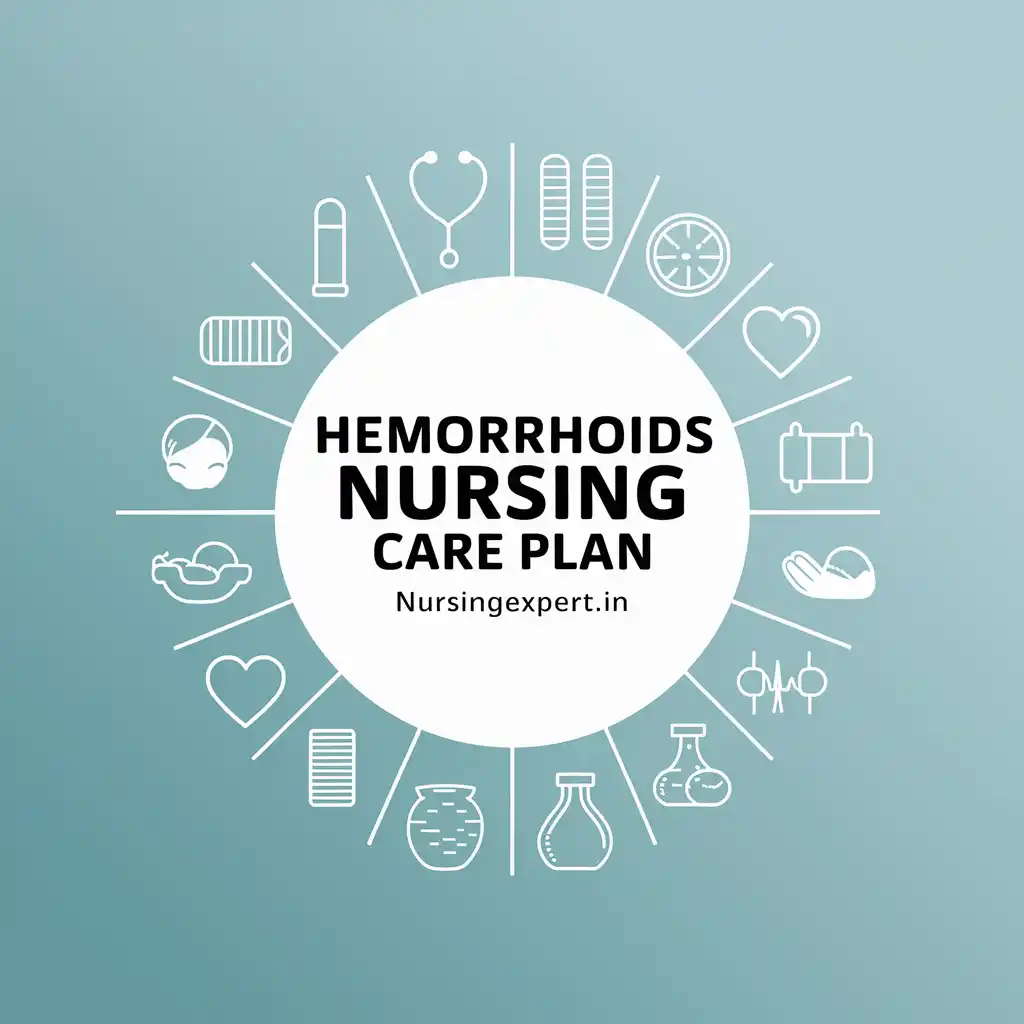Hemorrhoids are swollen veins in the lower rectum or anus that can cause discomfort, pain, and bleeding. A comprehensive nursing care plan for hemorrhoids is essential for managing symptoms, promoting healing, and educating patients about preventive strategies. This guide provides a step-by-step approach—from assessment to patient education—to support effective care. A downloadable PDF version of this care plan is available for clinical practice and exam preparation.
Thank you for reading this post, don't forget to subscribe!
Introduction
Overview of Hemorrhoids


Imagine if you had a small balloon that got too full of air and became soft and puffy. Hemorrhoids are a bit like that—but they happen in a part of our body called the rectum or around the bottom. They are swollen veins that can hurt or feel uncomfortable. Hemorrhoids come in two types:
- Internal Hemorrhoids: These are inside the lower part of your body and are usually not seen.
- External Hemorrhoids: These are found on the outside, near the opening of your bottom, and can be felt or seen.
Even though hemorrhoids are common, they can be very painful and bothersome. It is important for nurses and doctors to know how to help people feel better. Good nursing care makes sure that people who have hemorrhoids are comfortable and get the right treatment.
Purpose of the Article
This article is like a special guide for nurses and caregivers. It explains a complete plan for taking care of people with hemorrhoids. The plan includes:
- A careful look at the problem (hemorrhoids)
- Ways to help reduce pain and discomfort
- Ideas to make bowel movements easier
- Tips on teaching patients how to stay healthy
- Extra resources and a free PDF that nurses can download
By reading this guide, nurses and health care workers can learn how to help patients who suffer from hemorrhoids. The information is based on real research and proven ideas that work.
Understanding Hemorrhoids
Definition and Types
What are Hemorrhoids?
Hemorrhoids are swollen veins that can be found in two places:
- Inside the rectum: These are called internal hemorrhoids. They are hidden away and sometimes do not hurt, but they may bleed.
- Outside the rectum: These are called external hemorrhoids. They can be seen or felt and might be very painful, especially when touched.
Internal vs. External Hemorrhoids
- Internal Hemorrhoids: These develop inside your body. Even though they might not cause pain all the time, they can cause bleeding. You might not even know you have them until you see some blood when you go to the toilet.
- External Hemorrhoids: These develop outside your body. They can hurt a lot, and they might be red or swollen. Sometimes they can form a hard lump if a blood clot (called thrombosis) forms inside.
Etiology and Risk Factors
There are many reasons why people might get hemorrhoids. Here are some common risk factors:
- Straining During Bowel Movements: When you push too hard to go to the toilet, it puts extra pressure on your veins.
- Chronic Constipation or Diarrhea: Having trouble with regular bowel movements can hurt the veins.
- Pregnancy: Pregnant women have extra pressure on their body, which can lead to hemorrhoids.
- Obesity (Being Overweight): Extra weight puts more pressure on your body, including your rectum.
- Prolonged Sitting: Sitting for a long time without moving can make it hard for blood to flow well.
- Aging: As people get older, the tissues in the rectum and anus can become weaker.
- Hereditary Factors: Sometimes, hemorrhoids can run in families, so if your parents or grandparents had them, you might be more likely to get them too.
Signs, Symptoms, and Complications
When someone has hemorrhoids, they might notice some of these signs and symptoms:
- Pain: This is the most common symptom. The pain can be mild or very strong.
- Itching: The area around the anus can become itchy.
- Bleeding: Sometimes, there may be a small amount of blood when you go to the toilet.
- Prolapse: This means the hemorrhoid can stick out of the anus.
- Complications: In some cases, hemorrhoids can lead to problems like a blood clot (thrombosis) or an infection. When a blood clot forms, it can make the hemorrhoid very painful and hard.
Hemorrhoids may seem like a small problem, but they can cause a lot of discomfort. That is why nurses must have a good plan to help manage them and make sure patients feel better.
Nursing Assessment for Hemorrhoids
Before any treatment is given, nurses must check the patient carefully. This part of the care plan is called the “assessment.” The nurse gathers all the information needed by listening to the patient and looking at the signs.
Subjective Data
Subjective data means what the patient tells the nurse. It includes:
- Patient-Reported Pain: How much pain is the patient feeling? Is it a sharp pain, a dull pain, or a burning feeling?
- Itching and Discomfort: The patient might say that the area feels itchy or uncomfortable.
- Concerns About Bowel Habits: Sometimes, patients feel worried about how often they go to the toilet or if it hurts when they do.
- Quality of Life: Patients might tell the nurse how these symptoms are affecting their daily activities like playing, going to school, or even sleeping.
Objective Data
Objective data is what the nurse sees or measures:
- Visual and Physical Findings: The nurse may look at the bottom to see if there are any swollen, red, or inflamed veins. This can help the nurse know how bad the hemorrhoids are.
- Bowel Habit Evaluation: The nurse might ask questions or check records to see if the patient is having constipation (trouble going to the toilet) or diarrhea (loose, watery stools).
Additional Considerations
To get a full picture, nurses use some special tools:
- Pain Assessment Scales: These are simple charts or scales that help nurses rate the pain on a scale, like 1 to 10.
- Inspection of Perianal Skin and Rectal Area: The nurse carefully checks the skin around the anus and the rectum for any signs of injury or infection.
All this information helps the nurse understand how serious the problem is and decide what treatment is needed.
Nursing Diagnosis for Hemorrhoids
After gathering all the information, nurses make a list of problems. This list is called the “nursing diagnosis.” It helps in planning the right care.
Common Diagnoses
- Acute Pain Related to Inflammation:
- What It Means: The patient feels sharp or continuous pain because the area is inflamed (swollen and irritated).
- Impaired Skin Integrity Due to Friction and Irritation:
- What It Means: The skin around the hemorrhoids may be damaged because of rubbing or irritation.
- Constipation Resulting from Pain-Induced Avoidance of Defecation:
- What It Means: The patient might avoid going to the toilet because it hurts, which can make constipation worse.
- Deficient Knowledge Regarding Condition Management:
- What It Means: The patient may not understand what hemorrhoids are, why they hurt, or how to take care of themselves to avoid problems in the future.
Rationale
Each diagnosis is chosen because many patients with hemorrhoids show these problems. For example:
- If the patient says they feel a lot of pain when they go to the toilet, then “acute pain” is a good diagnosis.
- If the skin looks red and sore, the nurse notes “impaired skin integrity.”
- When patients do not go to the toilet because they fear pain, it can lead to constipation.
- If the patient does not know how to manage their condition, then they need more information.
By listing these diagnoses, nurses know exactly what to focus on in their care.
Nursing Interventions and Rationales
Now that the nurse has a list of problems, the next step is to plan what to do. These are the nursing interventions, which are the actions taken to help the patient.
Pain Management
Pain is a common problem with hemorrhoids. Here are some simple ways to help:
- Warm Sitz Baths:
Imagine sitting in a tub filled with warm water. This can help relax the muscles and reduce pain. Nurses may advise the patient to sit in a few inches of warm water for 10 to 15 minutes, several times a day.
Rationale: Warm water helps reduce swelling and eases discomfort. - Topical Analgesics and Prescribed Pain Medication:
These are creams or medicines that are applied directly to the affected area to make it less painful.
Rationale: They work directly on the pain spot to lower the pain and inflammation.
Promoting Bowel Regularity
It is important that patients can go to the toilet without pain. Nurses can help by:
- High-Fiber Diet:
Eating fruits, vegetables, and whole grains can help make stools softer. Think of fiber as a broom that cleans out your intestines so that food moves smoothly.
Rationale: A high-fiber diet helps reduce straining during bowel movements. - Adequate Fluid Intake:
Drinking plenty of water keeps the body hydrated and makes stools soft.
Rationale: More water in the body helps prevent constipation and makes it easier to pass stools. - Stool Softeners:
Sometimes, doctors give special medicines to help make stools softer, which makes them easier to pass.
Rationale: These help in preventing the strain that causes pain and further irritation of hemorrhoids.
Education and Prevention
Patients need to know how to take care of themselves to avoid more pain or future problems:
- Proper Hygiene:
After using the toilet, it is important to clean the area gently with warm water or baby wipes.
Rationale: Good hygiene prevents irritation and infection. - Avoiding Straining:
Teach patients to relax and not push too hard when going to the toilet.
Rationale: Straining can make hemorrhoids worse, so it is best to be gentle.
Topical Treatments and Medication Administration
Using creams, ointments, and suppositories is common in treating hemorrhoids:
- Creams and Ointments:
These are applied to the swollen area to reduce pain and swelling.
Rationale: They provide direct relief and help the skin heal. - Suppositories:
These are small tablets or capsules inserted into the rectum.
Rationale: They work from the inside to reduce inflammation and ease discomfort.
Lifestyle Modifications
Changing how a person lives can also help reduce the chances of getting more hemorrhoids:
- Weight Management:
Keeping a healthy weight reduces pressure on the rectum.
Rationale: Less pressure means fewer chances of developing or worsening hemorrhoids. - Regular Physical Activity:
Moving around and doing exercises can help keep the body healthy.
Rationale: Exercise improves blood circulation and helps with bowel movements. - Use of Supportive Cushions:
Sitting on a cushion, like a donut cushion, can help relieve pressure on the affected area.
Rationale: This makes sitting more comfortable and prevents extra pressure on the swollen veins.
Each of these interventions is chosen because it targets a specific problem the patient might have. By following these steps, nurses can help reduce pain, prevent complications, and improve the patient’s overall comfort and health.
Evaluation of Nursing Care
After the nurse has done everything planned, it is very important to check and see if the patient is getting better. This part is called “evaluation.”
Monitoring Improvement
Nurses keep track of the patient’s symptoms by:
- Tracking Pain:
The nurse asks, “How do you feel today? Is the pain less than yesterday?” This helps to see if the pain is going away. - Checking Swelling and Bleeding:
The nurse looks again at the affected area to see if the swelling has gone down and if there is less bleeding. - Evaluating Bowel Movements:
The nurse keeps a record of how often the patient goes to the toilet and whether the stools are soft or hard.
Patient Education and Compliance
It is very important that the patient understands the care plan. Nurses do this by:
- Teaching the Patient:
Nurses explain the care plan in simple words and show how to do things like sit in a warm bath or take medicine. - Making Sure the Patient Follows the Plan:
The nurse may ask the patient or their family to repeat the instructions to be sure they understand.
Documentation
Every step of the care process must be written down:
- Record Keeping:
Nurses write detailed notes about the patient’s condition, the treatments given, and how the patient responded.
Rationale: Good documentation helps keep track of progress and is useful for any future care.
Evaluation is like checking your homework. The nurse makes sure that all the steps are working and that the patient is slowly getting better. If something is not working, the nurse might change the care plan to help more.
Sample Nursing Care Plan for Hemorrhoids
Below is an example of a nursing care plan for hemorrhoids:
| Assessment | Nursing Diagnosis | Goal/Expected Outcome | Intervention/Planning | Implementation | Rationale | Evaluation |
|---|---|---|---|---|---|---|
| Subjective Data: – Patient reports pain and discomfort during bowel movements and notices blood on toilet paper. Objective Data: – Presence of swollen, tender tissue in the anal region; visible bright red blood. | Acute Pain related to hemorrhoidal inflammation as evidenced by patient-reported pain during defecation. | Short-Term: – Within 24 hours, reduce pain intensity to 3/10. Long-Term: – Patient experiences manageable pain and improved comfort during bowel movements. | Administer prescribed analgesics; recommend warm sitz baths and topical pain relievers; encourage proper hygiene. | Provide medications as ordered; instruct on sitz bath usage; assess pain levels every 4 hours. | Pain relief measures support comfort and promote healing. | Patient reports decreased pain; signs of inflammation reduce; improved comfort during defecation. |
| Subjective Data: – Patient expresses concerns about constipation and the need to avoid straining. Objective Data: – History of low-fiber diet; patient reports difficulty with regular bowel movements. | Impaired Urinary Elimination (related to defecation habits) due to constipation as evidenced by difficulty in bowel movements and straining. | Short-Term: – Within 24 hours, patient verbalizes understanding of dietary changes to prevent constipation. Long-Term: – Patient maintains regular bowel movements with a high-fiber diet and increased fluid intake. | Develop an education plan focusing on dietary modifications, increased fluid intake, and fiber supplementation; encourage scheduled toileting. | Conduct dietary counseling; provide written materials; monitor bowel habits and fluid intake. | Improved dietary practices reduce straining and prevent worsening hemorrhoids. | Patient demonstrates improved bowel habits; reports regular bowel movements; adherence to dietary changes confirmed. |
| Subjective Data: – Patient is uncertain about self-care practices for managing hemorrhoids. Objective Data: – Patient asks questions about hygiene, use of sitz baths, and when to seek medical help. | Deficient Knowledge regarding the management and prevention of hemorrhoids as evidenced by patient uncertainty. | Short-Term: – Within 24 hours, patient will describe proper self-care techniques. Long-Term: – Patient consistently applies self-care practices and follows up with regular medical evaluations. | Develop a comprehensive education plan that includes hygiene practices, sitz bath instructions, and dietary recommendations; provide visual and written resources. | Conduct one-on-one teaching sessions; distribute brochures; schedule follow-up reviews to reinforce learning. | Patient education is crucial for effective self-management and prevention of complications. | Patient verbalizes understanding; self-care practices are consistent; follow-up evaluations show effective management. |
Downloadable Nursing Care Plan for Hemorrhoids PDF Download
Nursing Care Plan for Hemorrhoids PDF Download
Access our complete nursing care plan for hemorrhoids PDF download. This comprehensive resource offers detailed, step-by-step instructions, nursing diagnoses, targeted interventions, and patient education strategies to manage hemorrhoids effectively. Use this document for clinical practice or exam preparation.
📥 Download Nursing Care Plan for Hemorrhoids PDF
Frequently Asked Questions (FAQs)
- What are hemorrhoids?
Hemorrhoids are swollen veins in the lower rectum or anus that can cause pain, itching, and bleeding. - What are common symptoms of hemorrhoids?
Symptoms include pain during bowel movements, visible blood on toilet paper, itching, and swelling around the anus. - How can hemorrhoids be managed?
Management includes pain relief, dietary modifications to prevent constipation, and proper hygiene to reduce irritation. - What lifestyle changes can help prevent hemorrhoids?
Increasing fiber intake, staying well-hydrated, exercising regularly, and avoiding prolonged sitting can help prevent hemorrhoids. - When should a patient seek medical help for hemorrhoids?
Seek help if symptoms worsen, bleeding becomes heavy, or if there is persistent pain and discomfort that does not improve with self-care.
Conclusion
A comprehensive nursing care plan for hemorrhoids is vital for alleviating pain, preventing complications, and promoting long-term healing. Through thorough assessment, targeted interventions, and effective patient education, nurses can empower patients to manage their condition and improve their quality of life.
References and Sources
- Mayo Clinic. (2023). Hemorrhoids: Symptoms, Causes, and Treatment. Retrieved from https://www.mayoclinic.org/diseases-conditions/hemorrhoids
- MedlinePlus. (2023). Hemorrhoids. Retrieved from https://medlineplus.gov/hemorrhoids.html
- NANDA International. (2022). NANDA Nursing Diagnoses: Definitions and Classifications. Retrieved from https://www.nanda.org/
- American Society of Colon and Rectal Surgeons. (2023). Understanding Hemorrhoids. Retrieved from https://www.fascrs.org
- Centers for Disease Control and Prevention (CDC). (2023). Preventing Hemorrhoids and Other Anorectal Conditions. Retrieved from https://www.cdc.gov


